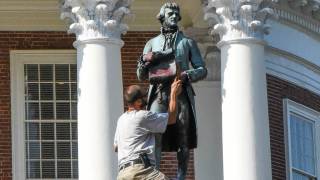The Dark Side of Thomas Jefferson
Source: smithsonianmag.com

A new portrait of the founding father challenges the long-held perception of Thomas Jefferson as a benevolent slaveholder
With five simple words in the Declaration of Independence—“all men are created equal”—Thomas Jefferson undid Aristotle’s ancient formula, which had governed human affairs until 1776: “From the hour of their birth, some men are marked out for subjection, others for rule.” In his original draft of the Declaration, in soaring, damning, fiery prose, Jefferson denounced the slave trade as an “execrable commerce ...this assemblage of horrors,” a “cruel war against human nature itself, violating its most sacred rights of life & liberties.” As historian John Chester Miller put it, “The inclusion of Jefferson’s strictures on slavery and the slave trade would have committed the United States to the abolition of slavery.”
That was the way it was interpreted by some of those who read it at the time as well. Massachusetts freed its slaves on the strength of the Declaration of Independence, weaving Jefferson’s language into the state constitution of 1780. The meaning of “all men” sounded equally clear, and so disturbing to the authors of the constitutions of six Southern states that they emended Jefferson’s wording. “All freemen,” they wrote in their founding documents, “are equal.” The authors of those state constitutions knew what Jefferson meant, and could not accept it. The Continental Congress ultimately struck the passage because South Carolina and Georgia, crying out for more slaves, would not abide shutting down the market.
“One cannot question the genuineness of Jefferson’s liberal dreams,” writes historian David Brion Davis. “He was one of the first statesmen in any part of the world to advocate concrete measures for restricting and eradicating Negro slavery.”
But in the 1790s, Davis continues, “the most remarkable thing about Jefferson’s stand on slavery is his immense silence.” And later, Davis finds, Jefferson’s emancipation efforts “virtually ceased.”
Somewhere in a short span of years during the 1780s and into the early 1790s, a transformation came over Jefferson.
The very existence of slavery in the era of the American Revolution presents a paradox, and we have largely been content to leave it at that, since a paradox can offer a comforting state of moral suspended animation. Jefferson animates the paradox. And by looking closely at Monticello, we can see the process by which he rationalized an abomination to the point where an absolute moral reversal was reached and he made slavery fit into America’s national enterprise.
We can be forgiven if we interrogate Jefferson posthumously about slavery. It is not judging him by today’s standards to do so. Many people of his own time, taking Jefferson at his word and seeing him as the embodiment of the country’s highest ideals, appealed to him. When he evaded and rationalized, his admirers were frustrated and mystified; it felt like praying to a stone. The Virginia abolitionist Moncure Conway, noting Jefferson’s enduring reputation as a would-be emancipator, remarked scornfully, “Never did a man achieve more fame for what he did not do.”
Thomas Jefferson’s mansion stands atop his mountain like the Platonic ideal of a house: a perfect creation existing in an ethereal realm, literally above the clouds. To reach Monticello, you must ascend what a visitor called “this steep, savage hill,” through a thick forest and swirls of mist that recede at the summit, as if by command of the master of the mountain. “If it had not been called Monticello,” said one visitor, “I would call it Olympus, and Jove its occupant.” The house that presents itself at the summit seems to contain some kind of secret wisdom encoded in its form. Seeing Monticello is like reading an old American Revolutionary manifesto—the emotions still rise. This is the architecture of the New World, brought forth by its guiding spirit.
In designing the mansion, Jefferson followed a precept laid down two centuries earlier by Palladio: “We must contrive a building in such a manner that the finest and most noble parts of it be the most exposed to public view, and the less agreeable disposed in by places, and removed from sight as much as possible.”
The mansion sits atop a long tunnel through which slaves, unseen, hurried back and forth carrying platters of food, fresh tableware, ice, beer, wine and linens, while above them 20, 30 or 40 guests sat listening to Jefferson’s dinner-table conversation. At one end of the tunnel lay the icehouse, at the other the kitchen, a hive of ceaseless activity where the enslaved cooks and their helpers produced one course after another.
During dinner Jefferson would open a panel in the side of the fireplace, insert an empty wine bottle and seconds later pull out a full bottle. We can imagine that he would delay explaining how this magic took place until an astonished guest put the question to him. The panel concealed a narrow dumbwaiter that descended to the basement. When Jefferson put an empty bottle in the compartment, a slave waiting in the basement pulled the dumbwaiter down, removed the empty, inserted a fresh bottle and sent it up to the master in a matter of seconds. Similarly, platters of hot food magically appeared on a revolving door fitted with shelves, and the used plates disappeared from sight on the same contrivance. Guests could not see or hear any of the activity, nor the links between the visible world and the invisible that magically produced Jefferson’s abundance.
Jefferson appeared every day at first light on Monticello’s long terrace, walking alone with his thoughts. From his terrace Jefferson looked out upon an industrious, well-organized enterprise of black coopers, smiths, nailmakers, a brewer, cooks professionally trained in French cuisine, a glazier, painters, millers and weavers. Black managers, slaves themselves, oversaw other slaves. A team of highly skilled artisans constructed Jefferson’s coach. The household staff ran what was essentially a mid-sized hotel, where some 16 slaves waited upon the needs of a daily horde of guests.
The plantation was a small town in everything but name, not just because of its size, but in its complexity. Skilled artisans and house slaves occupied cabins on Mulberry Row alongside hired white workers; a few slaves lived in rooms in the mansion’s south dependency wing; some slept where they worked. Most of Monticello’s slaves lived in clusters of cabins scattered down the mountain and on outlying farms. In his lifetime Jefferson owned more than 600 slaves. At any one time about 100 slaves lived on the mountain; the highest slave population, in 1817, was 140.
Below the mansion there stood John Hemings’ cabinetmaking shop, called the joinery, along with a dairy, a stable, a small textile factory and a vast garden carved from the mountainside—the cluster of industries Jefferson launched to supply Monticello’s household and bring in cash. “To be independent for the comforts of life,” Jefferson said, “we must fabricate them ourselves.” He was speaking of America’s need to develop manufacturing, but he had learned that truth on a microscale on his plantation.
Jefferson looked down from his terrace onto a community of slaves he knew very well—an extended family and network of related families that had been in his ownership for two, three or four generations. Though there were several surnames among the slaves on the “mountaintop”—Fossett, Hern, Colbert, Gillette, Brown, Hughes—they were all Hemingses by blood, descendants of the matriarch Elizabeth “Betty” Hemings, or Hemings relatives by marriage. “A peculiar fact about his house servants was that we were all related to one another,” as a former slave recalled many years later. Jefferson’s grandson Jeff Randolph observed, “Mr. Js Mechanics and his entire household of servants...consisted of one family connection and their wives.”
For decades, archaeologists have been scouring Mulberry Row, finding mundane artifacts that testify to the way that life was lived in the workshops and cabins. They have found saw blades, a large drill bit, an ax head, blacksmith’s pincers, a wall bracket made in the joinery for a clock in the mansion, scissors, thimbles, locks and a key, and finished nails forged, cut and hammered by nail boys.
The archaeologists also found a bundle of raw nail rod—a lost measure of iron handed out to a nail boy one dawn. Why was this bundle found in the dirt, unworked, instead of forged, cut and hammered the way the boss had told them? Once, a missing bundle of rod had started a fight in the nailery that got one boy’s skull bashed in and another sold south to terrify the rest of the children—“in terrorem” were Jefferson’s words—“as if he were put out of the way by death.” Perhaps this very bundle was the cause of the fight.
Weaving slavery into a narrative about Thomas Jefferson usually presents a challenge to authors, but one writer managed to spin this vicious attack and terrible punishment of a nailery boy into a charming plantation tale. In a 1941 biography of Jefferson for “young adults” (ages 12 to 16) the author wrote: “In this beehive of industry no discord or revilings found entrance: there were no signs of discontent on the black shining faces as they worked under the direction of their master....The women sang at their tasks and the children old enough to work made nails leisurely, not too overworked for a prank now and then.”
It might seem unfair to mock the misconceptions and sappy prose of “a simpler era,” except that this book, The Way of an Eagle, and hundreds like it, shaped the attitudes of generations of readers about slavery and African-Americans. Time magazine chose it as one of the “important books” of 1941 in the children’s literature category, and it gained a second life in America’s libraries when it was reprinted in 1961 as Thomas Jefferson: Fighter for Freedom and Human Rights.
In describing what Mulberry Row looked like, William Kelso, the archaeologist who excavated it in the 1980s, writes, “There can be little doubt that a relatively shabby Main Street stood there.” Kelso notes that “throughout Jefferson’s tenure, it seems safe to conclude that the spartan Mulberry Row buildings...made a jarring impact on the Monticello landscape.”
It seems puzzling that Jefferson placed Mulberry Row, with its slave cabins and work buildings, so close to the mansion, but we are projecting the present onto the past. Today, tourists can walk freely up and down the old slave quarter. But in Jefferson’s time, guests didn’t go there, nor could they see it from the mansion or the lawn. Only one visitor left a description of Mulberry Row, and she got a glimpse of it only because she was a close friend of Jefferson’s, someone who could be counted upon to look with the right attitude. When she published her account in the Richmond Enquirer, she wrote that the cabins would appear “poor and uncomfortable” only to people of “northern feelings.”
The critical turning point in Jefferson’s thinking may well have come in 1792. As Jefferson was counting up the agricultural profits and losses of his plantation in a letter to President Washington that year, it occurred to him that there was a phenomenon he had perceived at Monticello but never actually measured. He proceeded to calculate it in a barely legible, scribbled note in the middle of a page, enclosed in brackets. What Jefferson set out clearly for the first time was that he was making a 4 percent profit every year on the birth of black children. The enslaved were yielding him a bonanza, a perpetual human dividend at compound interest. Jefferson wrote, “I allow nothing for losses by death, but, on the contrary, shall presently take credit four per cent. per annum, for their increase over and above keeping up their own numbers.” His plantation was producing inexhaustible human assets. The percentage was predictable.
In another communication from the early 1790s, Jefferson takes the 4 percent formula further and quite bluntly advances the notion that slavery presented an investment strategy for the future. He writes that an acquaintance who had suffered financial reverses “should have been invested in negroes.” He advises that if the friend’s family had any cash left, “every farthing of it [should be] laid out in land and negroes, which besides a present support bring a silent profit of from 5. to 10. per cent in this country by the increase in their value.”
The irony is that Jefferson sent his 4 percent formula to George Washington, who freed his slaves, precisely because slavery had made human beings into money, like “Cattle in the market,” and this disgusted him. Yet Jefferson was right, prescient, about the investment value of slaves. A startling statistic emerged in the 1970s, when economists taking a hardheaded look at slavery found that on the eve of the Civil War, enslaved black people, in the aggregate, formed the second most valuable capital asset in the United States. David Brion Davis sums up their findings: “In 1860, the value of Southern slaves was about three times the amount invested in manufacturing or railroads nationwide.” The only asset more valuable than the black people was the land itself. The formula Jefferson had stumbled upon became the engine not only of Monticello but of the entire slaveholding South and the Northern industries, shippers, banks, insurers and investors who weighed risk against returns and bet on slavery. The words Jefferson used—“their increase”—became magic words.
Jefferson’s 4 percent theorem threatens the comforting notion that he had no real awareness of what he was doing, that he was “stuck” with or “trapped” in slavery, an obsolete, unprofitable, burdensome legacy. The date of Jefferson’s calculation aligns with the waning of his emancipationist fervor. Jefferson began to back away from antislavery just around the time he computed the silent profit of the “peculiar institution.”
And this world was crueler than we have been led to believe. A letter has recently come to light describing how Monticello’s young black boys, “the small ones,” age 10, 11 or 12, were whipped to get them to work in Jefferson’s nail factory, whose profits paid the mansion’s grocery bills. This passage about children being lashed had been suppressed—deliberately deleted from the published record in the 1953 edition of Jefferson’s Farm Book, containing 500 pages of plantation papers. That edition of the Farm Book still serves as a standard reference for research into the way Monticello worked.
[...]
Read the full article at: smithsonianmag.com
Image: SmithsonianMag.com
Book:
The Jefferson Lies: Exposing the Myths Youve Always Believed About Thomas Jefferson
Tune into Red Ice Radio:
Cort Lindahl - Geomantic Information Systems
Cort Lindahl - Hour 1 - Axis Mundi & Geomantic Talismans
Robert Hieronimus - The United Symbolism of America, All Seeing Eye Origins, Freemasons & The Enlightenment
Robert Hieronimus - The Founding Fathers of America, Secret Societies, The Illuminati & The Skull and Bones
Terry Melanson - Perfectibilists, The 18th Century Bavarian Order of the Illuminati






















